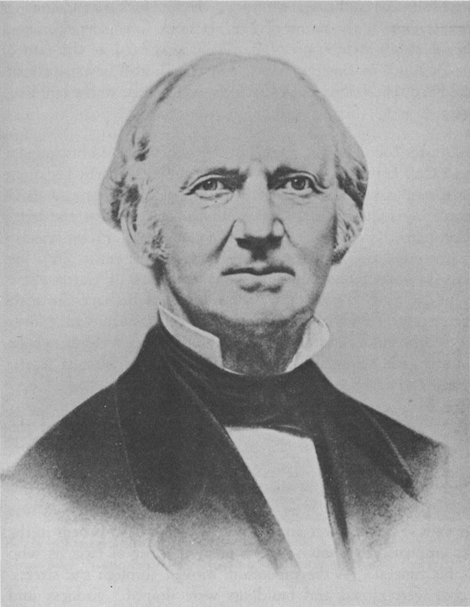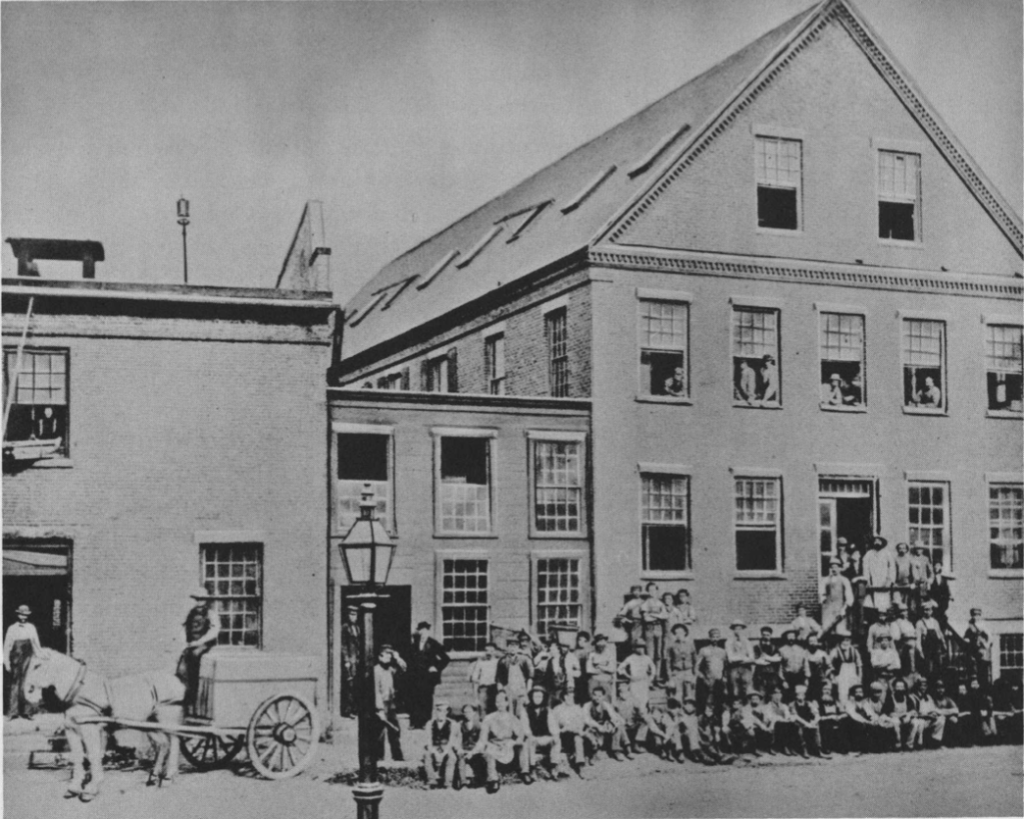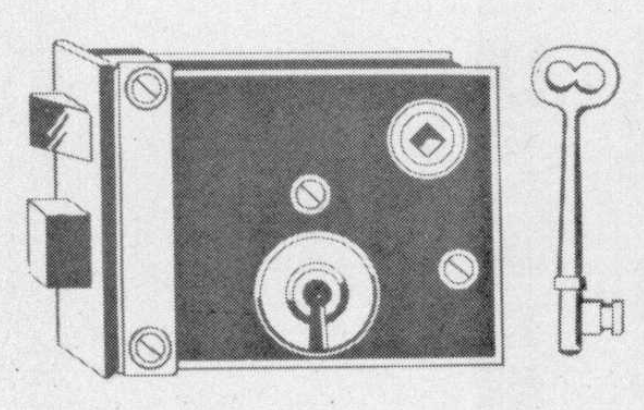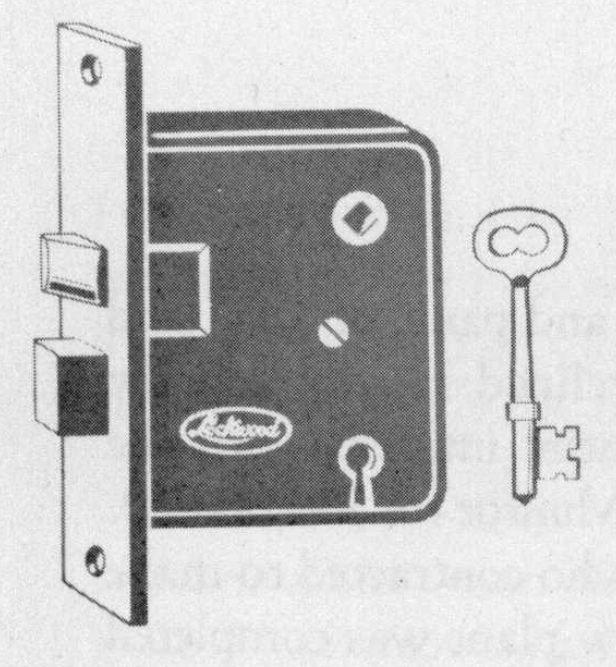Note: The following is a republished excerpt from the Lockwood Hardware Manufacturing Company’s Lockwood – The story of its past, the basis for its future. Published in 1953, and based almost entirely off of literature produced for Lockwood’s 1952 sales convention, it recounts the history of the Lockwood Hardware Manufacturing Company from 1834 until 1952.
By 1953, the Lockwood Hardware Manufacturing Company, then a division of the Independent Lock Company with both being headquartered in Fitchburg, Massachusetts, fielded branch offices in New York City, Philadelphia, Baltimore, Chicago, and Selma, Alabama along with five manufacturing plants in Fitchburg and one in Selma.
We have made no changes to this excerpt and what you see is exactly how it was printed in 1953, albeit in a different medium.
Preface
At the 1952 Sales Convention, a Pageant called “Lockwood Marches On” was presented by some sixty employees, executives and younger children of the coming generation, connected with the Company. The effort so far exceeded the hopes of the authors, that by sincere urging it has been re-edited and condensed as an historical record for friends of the Company to keep. It is the hope of the authors, that the reader will catch the inspiration, the human interest and the opportunity found possible only in the free enterprise system of America.
While admittedly, the story as written is designed to record the historical background and growth of the Lockwood Hardware Manufacturing Company, publicizing its struggles and achievements, recording its accomplishments and background, it is indeed more than that. It is a factual case of a brand name that has grown strong, over the years, in a free world. Statistics have been largely omitted, historical dates reduced to a minimum and only a few individuals have been named, so that the main story of Lockwood will stand out stronger.
It is a vital part of Lockwood’s history that back of the founders of the business, at each stage described, were many people who contributed much to the results recorded here. At no time in Lockwood’s history is the truth of the preceding statement better exemplified than as this history is written. However, time and space does not permit paying tribute individually.
The basic consideration in gathering the team that has been put together, has been the “know how” each individual has been able to bring into the organization to develop the policies and products now being offered. Lockwood Hardware Manufacturing Company is proud of its assembled team.
The following chapters set forth many of the important stages of the Company’s progress.
Chapter One, Nashua Lock Company 1834 to 1889
THE LOCKWOOD STORY really started way back in the year 1834 in Nashua, N. H., not so very far from Lockwood’s present location at Fitchburg, Mass. In this chapter is recorded the history of the Nashua Lock Company, whose products paved the way for the developments of the Lockwood line of today.
In the year 1834, Samuel Shepard, a manufacturer of doors and windows, formed a partnership with Charles Gay, who in 1832 had invented a “Rotary Grand Lock.” In Shepard’s fertile brain the thought was conceived that, if a lock could be placed in a mortise, it would be completely enclosed within the material of the door, instead of attached to the surface as were the English locks commonly in use at that time. Thus, with the germ of an idea was born the present mortise lock, which we have come to know so well.
With the founding of the new partnership, Shepard sold his sash and door business to devote full time to the new enterprise, the first lock manufacturing plant in this country, under the name of Nashua Lock Company, Nashua, N. H. In 1845 a public exhibition of hardware was held at the famed Mechanics Arts Building in Boston, Mass. and the Boston newspapers of that day gave credit to the Nashua Lock Company as founders of the builders’ hardware industry.
In 1835, one year after founding the company, Mr. Shepard sold his interest in the business to Col. Leonard W. Noyes and the infant concern began to prosper. There was a remarkable similarity in the personalities and characteristics of Col. Noyes and the founder of our parent company, the Independent Lock Company. Col. Noyes was born in Canaan, N. H. on January 14, 1779 and later moved to Nashua, where he spent his entire life. He married a young lady from Leominster, Mass., Ann Sewall Gardner, on Christmas Day in 1825. She was a lineal descendant of Richard Gardner, one of the Pilgrim fathers who came over on the Mayflower. Col. Noyes was an old time Whig, and a close political friend of Daniel Webster, whom he often entertained. he held public office and represented Nashua in the Legislature in 1830 and again in 1843.
Beside his interest in the Nashua Lock Company, he was also one of the promoters of the first sewing machine, the machine invented by Elias Howe, then a Nashua mechanic. Col. and Mrs. Noyes were exceedingly democratic in their hearts and in their regard for the people. “He was the poor man’s friend,” says the Nashua Gazette at the time of his death, “No appeal was made to him in vain.” The respect and esteem in which he was held in the community was emphatically shown by the great number of citizens who were present at this funeral. As the procession moved through the streets, bells tolled, stores were closed and buildings were draped. Sadness and gloom pervaded the city. Col. Noyes died in 1867 at the age of 88.
The site of the original plant was located on Factory Street, occupying a part of the old Bobbin Mill. The following notice appears in the history of Nashua, under date of 1845. “This establishment, of which L. W. Noyes and David Baldwin are proprietors, is employed in the manufacturer of mortise locks and latches for dwelling house doors and rose wood and brass knobs for handles of the same. They usually have, in their employment, about 40 men and manufactured $35,000.00 worth of goods last year. This embraced 56,517 locks and latches and 35,000 pair of rose wood knobs.”

Colonel Leonard W. Noyes. A co-founder of the Nashua Lock Company and a leading New England industrialist of the early 19th century.
During the year 1853, Robert G. Livingston of Boston became a partner and salesroom were opened in Boston. Mr. C. B. Hill was elected Treasurer and hard charge of the salesrooms. Mr. Sabine Traverse was appointed superintendent and continued in that capacity for ten years. In 1854, David Baldwin, who had been associated with Shepard in the door business, died. He was succeeded by J. W. Otterson. At one time they employed more than 100 men.
During the years following, because of the depression and panic of 1857 and some disagreement between the partners, business declined rapidly and the company was forced to reorganize. In 1859, the entire interest, with the exception of the iron foundry, was purchased by F. O. Munroe for $30,000.00. The iron foundry remainder the property of Otterson, who contracted to make all the castings for the Lock Company. In 1860, a new plant was completed on Spring Street with a new foundry closely adjacent. In 1863, incorporation completely revolutionized the business, which took a new lease on life. Mr. Munroe remained as the nominal head of the company until 1872.
The company was incorporated for $60,000.00, with 150 employees and a monthly payroll of $6,000.00 and, during the next few years, the business against prospered. During the great Boston fire of 1872, the entire stock of of the Boston Office was lost and with this tragedy there again started a period of decline. A few years after the fire, control of the company passed to a group of financiers, headed by H. G. Bixby. This group recognized the fact that a valuate enterprise was slipping from the hands of the Nashua Lock Company because of faulty tools and methods and a gallant fight was made to regain supremacy in this line, but the fight was useless. The hold obtained by their competitors was too strong and it was found necessary for Nashua to surrender the enterprise to outside interests.
It is interesting to note that the iron foundry remainder in the hands of J. D. Otterson until he died in 1880. Following his death, the business changed hands several times without success. Finally, because of the wages owed employees, the company was re-organized on a co-operative basis and became the first co-operative iron foundry in the United States. In passing, it is of interest to note that Col. Noyes, on disposing of his interest in the Nashua Lock Company, formed a new enterprise, the Nashua Watch Company, of which he became Treasurer. This company was later sold and became the Waltham Watch Company, makers of the famous Waltham Watch.



